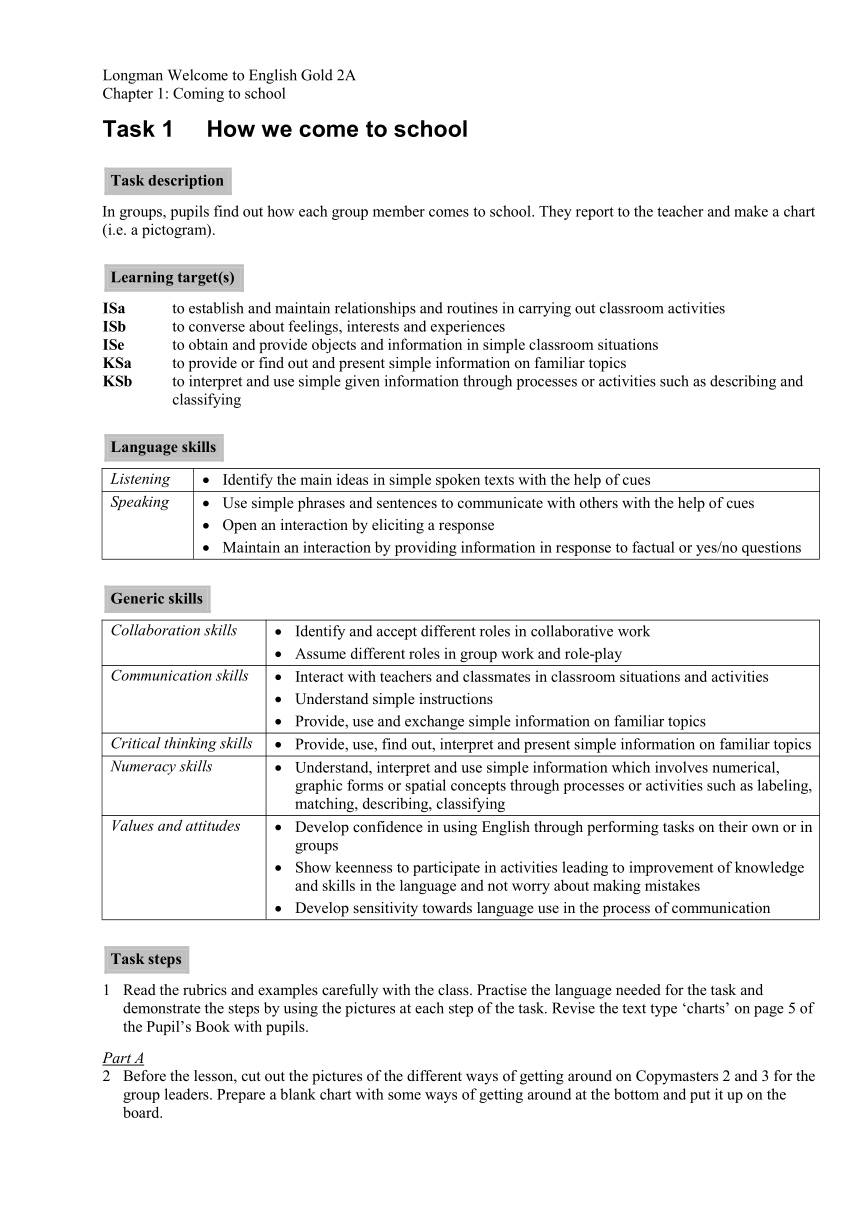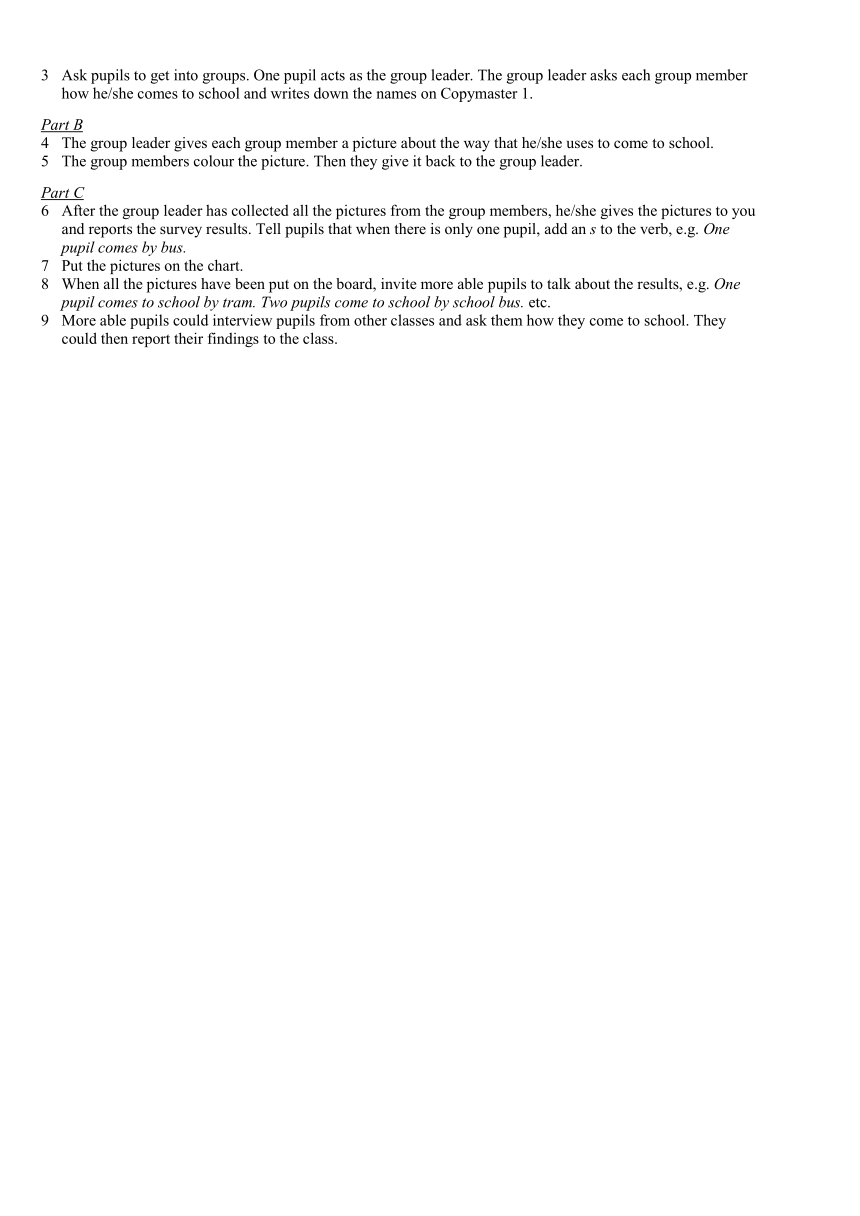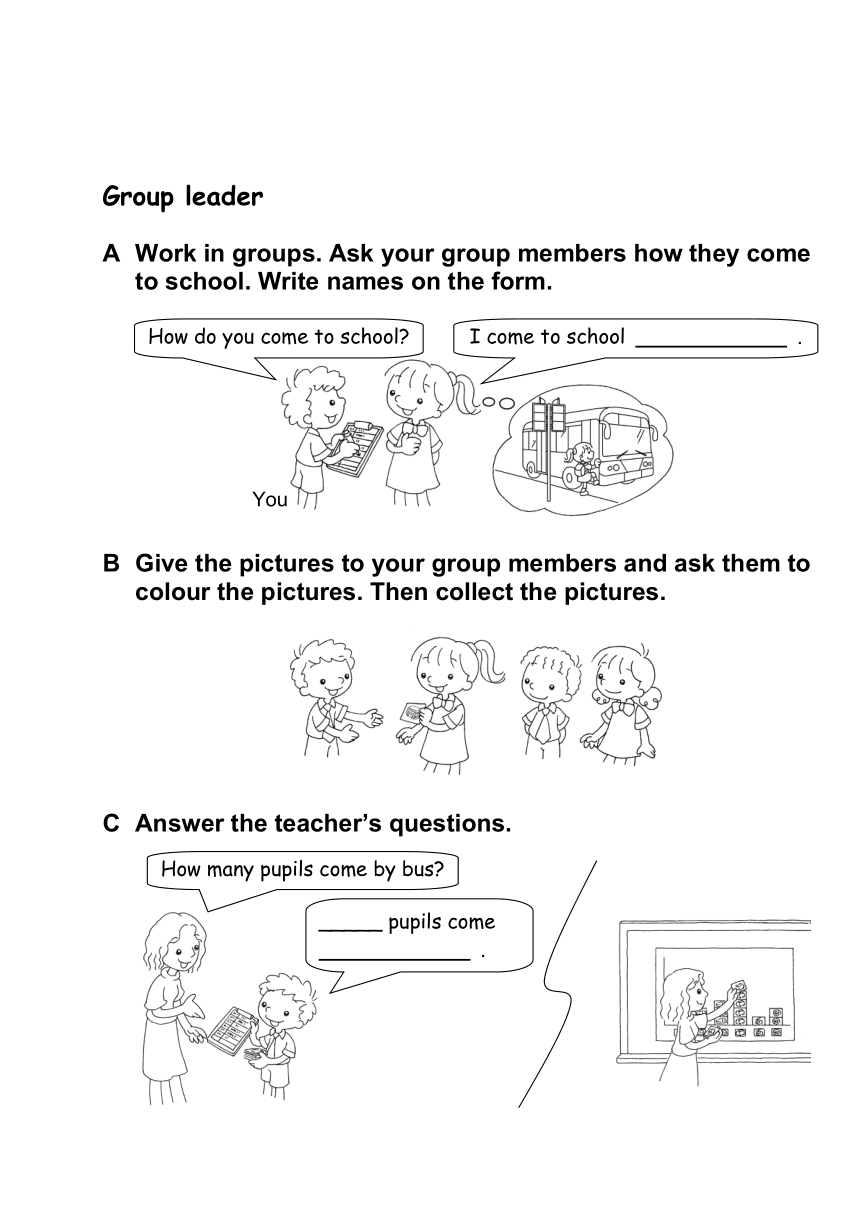新思维小学英语 2 A Chapter 1 Coming to school学习任务单(无答案)
文档属性
| 名称 | 新思维小学英语 2 A Chapter 1 Coming to school学习任务单(无答案) |  | |
| 格式 | docx | ||
| 文件大小 | 554.2KB | ||
| 资源类型 | 教案 | ||
| 版本资源 | 其它版本 | ||
| 科目 | 英语 | ||
| 更新时间 | 2023-08-28 21:38:03 | ||
图片预览



文档简介
Longman Welcome to English Gold 2A
Chapter 1: Coming to school
Task 1 How we come to school
Task description
In groups, pupils find out how each group member comes to school. They report to the teacher and make a chart (i.e. a pictogram).
Learning target(s)
ISa to establish and maintain relationships and routines in carrying out classroom activities
ISb to converse about feelings, interests and experiences
ISe to obtain and provide objects and information in simple classroom situations
KSa to provide or find out and present simple information on familiar topics
KSb to interpret and use simple given information through processes or activities such as describing and classifying
Language skills
Listening Identify the main ideas in simple spoken texts with the help of cues
Speaking Use simple phrases and sentences to communicate with others with the help of cues Open an interaction by eliciting a response Maintain an interaction by providing information in response to factual or yes/no questions
Generic skills
Collaboration skills Identify and accept different roles in collaborative work Assume different roles in group work and role-play
Communication skills Interact with teachers and classmates in classroom situations and activities Understand simple instructions Provide, use and exchange simple information on familiar topics
Critical thinking skills Provide, use, find out, interpret and present simple information on familiar topics
Numeracy skills Understand, interpret and use simple information which involves numerical, graphic forms or spatial concepts through processes or activities such as labeling, matching, describing, classifying
Values and attitudes Develop confidence in using English through performing tasks on their own or in groups Show keenness to participate in activities leading to improvement of knowledge and skills in the language and not worry about making mistakes Develop sensitivity towards language use in the process of communication
Task steps
Read the rubrics and examples carefully with the class. Practise the language needed for the task and demonstrate the steps by using the pictures at each step of the task. Revise the text type ‘charts’ on page 5 of the Pupil’s Book with pupils.
Part A
Before the lesson, cut out the pictures of the different ways of getting around on Copymasters 2 and 3 for the group leaders. Prepare a blank chart with some ways of getting around at the bottom and put it up on the board.
Ask pupils to get into groups. One pupil acts as the group leader. The group leader asks each group member how he/she comes to school and writes down the names on Copymaster 1.
Part B
The group leader gives each group member a picture about the way that he/she uses to come to school.
The group members colour the picture. Then they give it back to the group leader.
Part C
After the group leader has collected all the pictures from the group members, he/she gives the pictures to you and reports the survey results. Tell pupils that when there is only one pupil, add an s to the verb, e.g. One pupil comes by bus.
Put the pictures on the chart.
When all the pictures have been put on the board, invite more able pupils to talk about the results, e.g. One pupil comes to school by tram. Two pupils come to school by school bus. etc.
More able pupils could interview pupils from other classes and ask them how they come to school. They could then report their findings to the class.
Group leader
(
I come to school
.
) (
How do you come to school
)Work in groups. Ask your group members how they come to school. Write names on the form.
(
You
)
Give the pictures to your group members and ask them to colour the pictures. Then collect the pictures.
(
How many pupils come by bus
)Answer the teacher’s questions.
(
_____ pupils come
.
)
Group members
Work in groups. Tell your group leader how you come to school.
(
You
) (
I come to school
.
) (
How do you come to school
)
Colour the picture and give it to the group leader.
1
(
Thank you.
) (
Here you are.
)2
Group ______ Names of pupils
(
1
)
(
3
)
(
Task 1
How well did you do Circle.
‘
A
’
is the best.
Did you ask questions
correctly
A B C D E
Did you answer the questions correctly
A B C D E
Did you use the
correct action words, e.g. come
A B C D E
Complete the sentence.
You can t
ick (
)
more than one choice
.
I can do better next time. I can …
ask questions
correctly
.
answer the questions correctly.
use the
correct action words, e.g. come
.
)
Chapter 1: Coming to school
Task 1 How we come to school
Task description
In groups, pupils find out how each group member comes to school. They report to the teacher and make a chart (i.e. a pictogram).
Learning target(s)
ISa to establish and maintain relationships and routines in carrying out classroom activities
ISb to converse about feelings, interests and experiences
ISe to obtain and provide objects and information in simple classroom situations
KSa to provide or find out and present simple information on familiar topics
KSb to interpret and use simple given information through processes or activities such as describing and classifying
Language skills
Listening Identify the main ideas in simple spoken texts with the help of cues
Speaking Use simple phrases and sentences to communicate with others with the help of cues Open an interaction by eliciting a response Maintain an interaction by providing information in response to factual or yes/no questions
Generic skills
Collaboration skills Identify and accept different roles in collaborative work Assume different roles in group work and role-play
Communication skills Interact with teachers and classmates in classroom situations and activities Understand simple instructions Provide, use and exchange simple information on familiar topics
Critical thinking skills Provide, use, find out, interpret and present simple information on familiar topics
Numeracy skills Understand, interpret and use simple information which involves numerical, graphic forms or spatial concepts through processes or activities such as labeling, matching, describing, classifying
Values and attitudes Develop confidence in using English through performing tasks on their own or in groups Show keenness to participate in activities leading to improvement of knowledge and skills in the language and not worry about making mistakes Develop sensitivity towards language use in the process of communication
Task steps
Read the rubrics and examples carefully with the class. Practise the language needed for the task and demonstrate the steps by using the pictures at each step of the task. Revise the text type ‘charts’ on page 5 of the Pupil’s Book with pupils.
Part A
Before the lesson, cut out the pictures of the different ways of getting around on Copymasters 2 and 3 for the group leaders. Prepare a blank chart with some ways of getting around at the bottom and put it up on the board.
Ask pupils to get into groups. One pupil acts as the group leader. The group leader asks each group member how he/she comes to school and writes down the names on Copymaster 1.
Part B
The group leader gives each group member a picture about the way that he/she uses to come to school.
The group members colour the picture. Then they give it back to the group leader.
Part C
After the group leader has collected all the pictures from the group members, he/she gives the pictures to you and reports the survey results. Tell pupils that when there is only one pupil, add an s to the verb, e.g. One pupil comes by bus.
Put the pictures on the chart.
When all the pictures have been put on the board, invite more able pupils to talk about the results, e.g. One pupil comes to school by tram. Two pupils come to school by school bus. etc.
More able pupils could interview pupils from other classes and ask them how they come to school. They could then report their findings to the class.
Group leader
(
I come to school
.
) (
How do you come to school
)Work in groups. Ask your group members how they come to school. Write names on the form.
(
You
)
Give the pictures to your group members and ask them to colour the pictures. Then collect the pictures.
(
How many pupils come by bus
)Answer the teacher’s questions.
(
_____ pupils come
.
)
Group members
Work in groups. Tell your group leader how you come to school.
(
You
) (
I come to school
.
) (
How do you come to school
)
Colour the picture and give it to the group leader.
1
(
Thank you.
) (
Here you are.
)2
Group ______ Names of pupils
(
1
)
(
3
)
(
Task 1
How well did you do Circle.
‘
A
’
is the best.
Did you ask questions
correctly
A B C D E
Did you answer the questions correctly
A B C D E
Did you use the
correct action words, e.g. come
A B C D E
Complete the sentence.
You can t
ick (
)
more than one choice
.
I can do better next time. I can …
ask questions
correctly
.
answer the questions correctly.
use the
correct action words, e.g. come
.
)
同课章节目录
